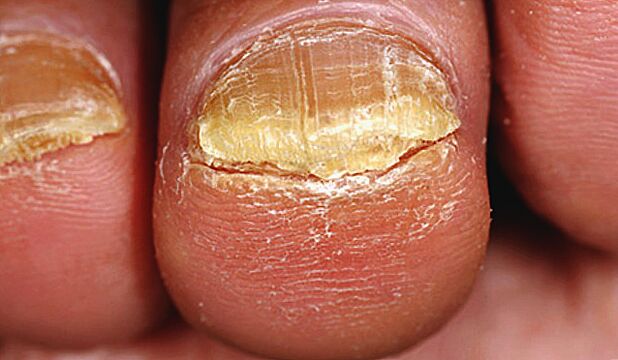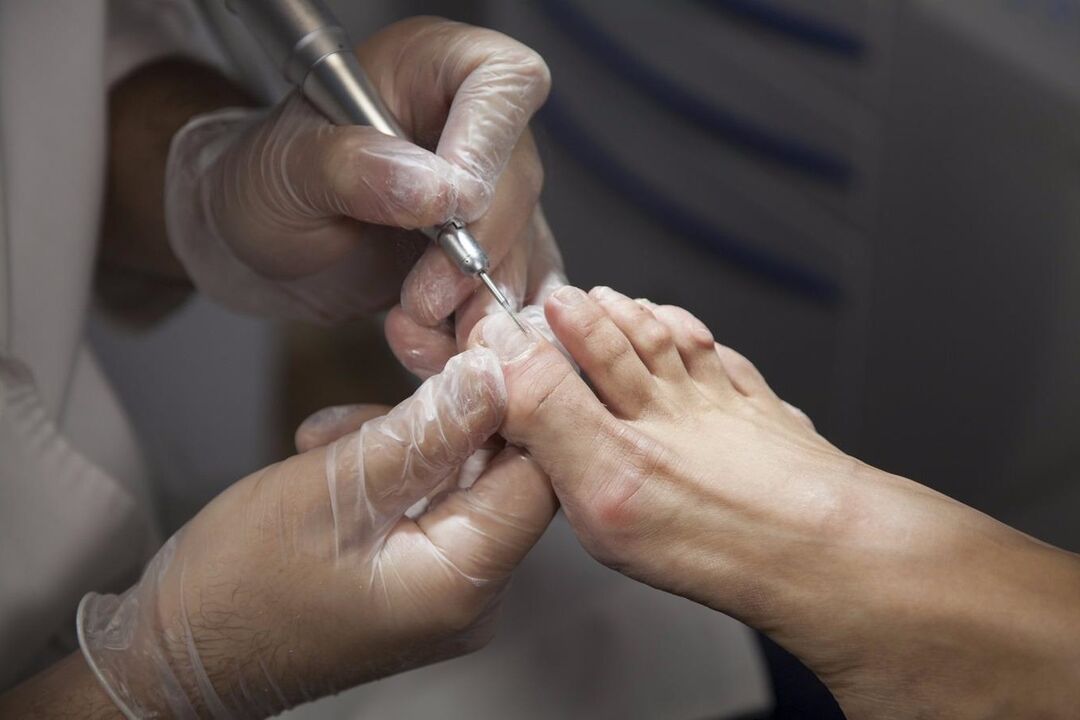The so-called fungus on the nails (onychomycosis) is one of the most common infectious skin diseases and one of the most difficult to treat. The absence of obvious symptoms of infection in the initial stages of the disease is the reason for the late diagnosis of onychomycosis and therefore delayed treatment.

type of fungus
Onychomycosis is caused by pathogenic fungi of the genus Trichophyton, which penetrate the tissues of the nail plate and nail bed, gradually destroying them and causing negative changes in local immunity.
According to the clinical manifestations of nail fungus, three diseases can be distinguished:
- Normal Nutrition - In this case, the nail plate maintains its normal thickness, but is painted in colors not commonly found in healthy nails (cloud white, yellow-gray, beige, etc. ).
- Hypertrophy is characterized by excessive thickening of the nail, which rises from the surface of the nail bed and protrudes strongly beyond its boundaries. Deformation of the plate is often observed in this form - it becomes noticeably bumpy, increases in width and causes pain when walking as it grows into soft tissue.
- The atrophic form manifests as thinning of the nails and a cloudy color (sometimes with gray-yellow spots, streaks, or "bubbles"). It's important to remember that only experts know how to identify toenail fungus. It will be very difficult to get rid of advanced nail fungus without surgery.

If you notice any signs of fungus on your nails, hands, or other areas, you should seek immediate advice from a dermatologist.
symptom
The presentation of onychomycosis can be divided into three groups, which vary according to the severity of the damage to the nail plate.
- I stage (initial). At this stage of disease development, the nail retains its normal thickness and color, but its surface becomes dull and tarnished. The cuticle and skin around the nails may look overly dry and rapidly keratinize. During the same stage, scaling between the toes and pruritus of varying severity can be observed - from mild occasional to severe and permanent.
- Phase II (developed). In the second stage, visual signs of infection appear on the nail. The nail plate starts to thicken, but at the same time becomes brittle - when the nail is clipped, it becomes apparent that it will "crack" and there will still be uneven edges at the cut site. White, yellow, gray, or brown spots or streaks on the nail, uneven relief on the surface of the nail. Nail thickening can progress to the point where any manipulation on it (manicure, pedicure) is painful. At this stage, the affected nails (especially onychomycosis on the legs) develop an unpleasant odor, which cannot be eliminated with the help of hygiene procedures.
- Stage III (severe). At this stage of onychomycosis, the nail completely loses its function and quality, and the fungal infection spreads to the nail folds and soft tissues under the nail. The most common feature of this stage is the death and loss of the nail.
fungal cause

Onychomycosis has only one cause: infection with pathogenic fungi, and their growth and reproduction in the nail tissue.
But this nearly ubiquitous fungus only affects some people. The reason is simple: infection requires not only pathogens, but also conditions conducive to infection.
These include:
- Decreased local immunity. Skin and nails have their own resources to prevent infection. But when wearing tight and uncomfortable shoes, frequent or recurring skin damage, overly thorough and deep pedicures/manicures, exposure to caustic substances, the protective function of the skin and nails is weakened, which favors the penetration and reproduction of fungi.
- Occupational or daily activities involving prolonged exposure of hands/feet to moisture. This doesn't have to be in direct contact with water or other liquids - wearing rubber shoes and gloves creates a warm and humid environment that is conducive to pathogenic fungi.
- Failure to follow personal hygiene rules can lead to subungual fungus. Wearing other people's shoes, lack of personal shoes when going to public swimming pools and saunas, not changing fresh socks and socks in time, etc.
Nail Fungus: Treatment

The peculiarities of the nails themselves complicate the treatment of onychomycosis, the density of which does not allow the penetration of drugs into their deep layers.
Therefore, for fungal infections of the nails, the thickness of the nails is usually artificially reduced with the help of special nail files. This frees the surface of the nail plate from its densest outer layer, thereby increasing the ability of the pharmaceutically active substance to be deeply absorbed.
Due to the deep lesions of the nail involving the nail bed tissue during this procedure, surgical removal of the nail plate under local anesthesia is recommended. After that, treatment is based on the severity of the disease.
To date, the only way to get rid of onychomycosis is with antifungal medication. These drugs selectively act on the pathogenic fungi, preventing their activity and reproduction, resulting in the death of the pathogen.
Depending on how far the fungus has spread to the tissues around the nail and whether the pathogen has invaded the bloodstream, oral systemic antifungals or topical effective medications (ointments, creams, solutions) may be prescribed.

















